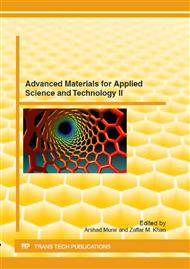[1]
Anand, S.C., et al., Mechanical bonding, in Handbook of nonwovens, S.J. Russell, Editor. 2007, Woodhead Publishing Limited: Cambridge. pp.255-294.
Google Scholar
[2]
Munstermann, U., W. Moschler, and A. Watzl, eds. Nonwoven fabrics. ed. W. Albrecht, H. Fuchs, and W. Kittelmann. 2003, Wiley-VCH: Cambridge.
Google Scholar
[3]
Kennedy, T., An Overview of Roofing, in Roofing Instant Answers. (2002).
Google Scholar
[4]
Adanur, S., ed. Wellington Sears handbook of industrial textiles. 1995, Technomic Pub.: Lancaster, Pa.
Google Scholar
[5]
Frijlink, J.J., Bituminious roofing membranes, in Nonwoven fabrics, W. Albrecht, H. Fuchs, and W. Kittelmann, Editors. 2003, Wiley-VCH: Weinheim. pp.586-592.
Google Scholar
[6]
Droux, M., et al., Complex comprising a drylaid veil of glass fibres and a nonwoven fabric of organic fibres. Patent 7669303, 2008: USA.
Google Scholar
[7]
Cullen, W.C. Research and Performance experience of Asphalt Shingles. in 10th Conference on Roofing Technology. 1993. Gaithersburg, MD, USA: NRCA.
Google Scholar
[8]
Noone, M.J. and W.K. Blanchard. Asphalt Shingles-A century of success and improvement. in 10th Conference on Roofing Technology. 1993. Gaithersburg, MD, USA: NRCA.
Google Scholar
[9]
Albrecht, W., H. Fuchs, and W. Kittelmann, eds. Nonwoven fabrics. 2003, Wiley-VCH: Cambridge.
Google Scholar
[10]
Scheerlinck, P.M., S.M. Rapp, and W. Greiser, Method for producing a reinforced polyester non-woven material. Patent 7662252 B2, 2006: USA.
Google Scholar
[11]
Plotz, K., Hydrodynamically bounded carrier webs and use thereof, Patent 6412154 B1, 2001: USA.
Google Scholar
[12]
Baravian, J., et al., Process for the production of two-layer textile reinforcement adapted for the production of bituminous sealing sheets for roofing and reinforcement thus obtained, Patent 5, 616, 395, 1997: USA.
Google Scholar
[13]
Lehnert, J., et al., Laminate with Improved Properties, Patent 7, 494, 558 B2, 2003: USA.
Google Scholar
[14]
Jaganathan, S., et al., A study on compression-induced morphological changes of nonwoven fibrous materials. Colloids and Surfaces A: Physicochemical and Engineering Aspects, 2009. 337(1-3): pp.173-179.
DOI: 10.1016/j.colsurfa.2008.12.019
Google Scholar
[15]
Eberhardt, C.N. and A.R. Clarke, Automated reconstruction of curvilinear fibres from 3D datasets acquired by x-ray microtomography. Journal of Microscopy, 2002. 206(1): pp.41-53.
DOI: 10.1046/j.1365-2818.2002.01009.x
Google Scholar
[16]
Knops, M., Analysis of failure in fiber polymer laminates: The Theory of Alfred Puck. 2008, Berlin: Springer.
Google Scholar


